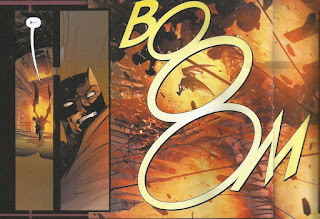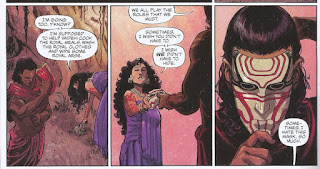Pick of the Brown Bag
November 28, 2018
by
Ray Tate
I’m back in…a Flash. Welcome to the Pick of the Brown Bag, in this blog I pick the best and the worst of comic books for the week. This edition features reviews of Albert Einstein Time Mason, Batgirl, Detective Comics, Red Sonja, Scooby-Doo Team-Up, These Savage Shores and Titans. If you haven’t time for the meatier reviews, check out the tweets on Twitter: #PickoftheBrownBag. Already live, also with commentary on comic books not reviewed here.
Ken Berry died on Monday. As a child I first became aware of him in Herbie Rides Again and The Cat from Outer Space. As an adolescent, I enjoyed his pratfalls on F Troop, but he had a long career of entertaining with music, comedy and dance. You felt good when you saw Ken Berry in The Carol Burnett Show or when playing against type on numerous television series like Ellery Queen. Here he lives on.
Titans sports an incredibly deceptive cover. The photo depicts the original Teen Titans of the New 52, a group actually only existing as flashbacks. It bears little on what’s going on in the current issue. That said. I’m still recommending the book because of Dan Abnett’s heartfelt writing and Minkyu Jung's expressive artwork.
Here’s what you missed. The Source Wall broke apart and released source energy throughout the universe. This happened in some other series: either Justice League or Metal. The source energy fueled another meta-human trigger event. So, teenagers were popping up all over earth with superpowers and no idea what to do with them.
The empowered, termed emergents, inspired Dick Grayson to ask the Justice League to permit him to lead a new version of the Titans. The League agree. There’s one catch. The Titans must be chosen for tactical purposes. They cannot be a clubhouse of sidekick buddies. So the Titans become Nightwing, Donna Troy, Natasha Irons’ Steel, Beast Boy, Raven and Miss Martian.
Events in Batman precipitate an amnesiac Dick Grayson, and Heroes in Crisis affect the original Titans even more. Another Justice League/Aquaman crossover muddies the lineup, and it’s that situation that marooned the Titans on the alien planet.
Various stressors force Miss Martian to revert to her original state. Beast Boy goes feral. Soon, it’s “monster” vs “monster” with Titans in the middle.
So far none of this is particularly groundbreaking, but when you read the Titans, you hear the dialogue of heroism and distinctive characterization.
You hear a bond between heroes that refuse to give in and use this terrible situation to become better. That’s why I recommend this story.
James Robinson’s terrific Detective Comics teams Batman with one of his top tier rogues Two-Face against perpetual losers Kobra. Detective Comics has been one of the best reasons to go to the comic book store. The conclusion is a brilliant tonic.
On the surface it appears that the final chapter just acts as cleanup duty. Kobra cultists happen to already be in the sewers ready to poison Gotham’s water supply with a mind-controlling substance.
The flip of a coin decides who will be Kobra’s new number one nightmare, and it turns out that Two-Face reaches them first. Batman deals with another contingent. Will Two-Face give up his life in the pursuit of random justice?
Peter Tomasi ended Two-Face at the conclusion of his Batman/Two-Face story in Batman and Robin. In a moment that’s one of the most realistic in comic books, Two-Face kills himself. His mental illness, for Two-Face is indeed a victim of multiple-personality syndrome, gets the better of him. Off panel, he pulls the trigger.
The soft reboot Rebirth was just that. Two-Face lives. Robinson rebuilt Two-Face with more stability on both his sides. It’s that stability that led Two-Face not Harvey Dent to a complex insight. The epiphany allowed Two-Face to perform a service for the good without betraying his duality.
According to Robinson, the scarred side is the most dominant of the two personalities. Two-Face though abides by the flip of the coin and lets Harvey Dent act when the unscarred side shows its visage.
The difference in this story is that Two-Face must act against Kobra to balance out the bad that Harvey perpetrated. At least that’s what the villain claims. In any case, Robinson’s conclusion doesn’t present a cut-and-dried redemption. Two-Face’s outcome in fact is just as intricate as his reasoning behind the employ of twin Fireflies. The layers make Batman’s masterful deduction all that more satisfying. Truly Robinson presented a detective story, and it was a mystery that demanded “The World’s Greatest Detective.”
Gail Simone introduced a gentlemen thief with a Japanese menpo mask in early issues of Batgirl. Grotesque meant to recall such literary ancestors as Arsene Lupin and Flambeau. Dressed in tuxedo and sporting an electrified cane, he robbed from the rich to give to himself.
In Mairghread Scott's reintroduction, Grotesque appeared to escalate his crimes. Murdering his victims and refashioning them into works of art that matched his name. This escalation seemed anomalous to Grotesque’s original m.o., which involved no signature of murderous intent.
It's very easy to deduce the identity of Grotesque once you know it's not the same man. What we didn’t know until later chapters is that Scott’s entire story thematically relates to the genre of body horror.
Grotesque’s fight against Batgirl leaves Babs with a malfunctioning chip granting her mobility and an unreliable memory; a near impossibility since Batgirl possesses the natural superpower of eidetic recall.
Both blows remind her of the insult to her body. Paul Pelletier’s artwork demonstrates that the repair instituted scarring. You can argue that it's body modification.
Scott opened Batgirl with what appeared to be the return of a Batgirl foe. She next unveiled a body double before introducing a recent body horror threat inherited from Nightwing.
Scott’s finale sets the scene at a gala attended by Batgirl’s father Commissioner Gordon. Unlike the original Grotesque who liked the rich in the same way one likes a steak, the new version displays a pathological hatred of the haves. That’s one of the reasons why he was so easy to recruit to the master villain’s cause.
To keep his pawn in check, the master villain used of course the promise of the flesh. This gave the hapless victim a purpose to follow. Batgirl however sees the reality of the situation.
Her clarity grants her the power to break through the conditioning, social and artificial, and secure a win against a literal ticking clock.
At the same time, Batgirl does not fall for the trickery of the master villain. The perversion is transparent to her, and her vision lends to an exciting, high-kicking ending.
Red Sonja is a done in one story that takes a lot of departures from the traditional fantasy. I’m crediting that to Amy Chu. Though I suppose co-writer Erik Burnham could be just as enlightened. The story begins with an interruption of Sonja’s travels.
The Justice Goddess transports Sonja to her worshipper’s throne room. Chu and Burnham, we’ll give him the benefit of assumption, immediately demonstrate that Sonja cannot defeat this goddess. She’s too powerful. She is at the mercy of Justice who grants her worshipper a boon that Sonja will deliver.
Naturally, the male of the tale comes up with the perfect lecherous solution to balance the scales. In a brilliant twist, Chu and Burnham defuse the toxic masculinity.
The story is inventive in the framework of a traditional quest, and Robert Castro’s artwork is excellent. Sonja’s personality comes out in the dialogue, and the use of the bestiary adds novelty to Sonja’s usual battles against evil rulers and their minions. Though they have their places.
These Savage Shores premiered impressively by upending the vampire myth. A vampire went to India, and he met Bishan, an erudite deity fallen to earth and making time with Kori, a royal servant.
The meeting did not go well and left unanswered questions for vampire hunter Zachariah Sturn. He's the cause of the vampire's trip, and the catalyst for demise.
Personally, I feel that Zach should leave well enough alone. Arrogant bloodsucking bastard Alain Pierrefont is no more? Good riddance to undead rubbish. Sturn however believes he follows his nature. He’s a hunter of the supernatural, and whatever killed Alain is supernatural.
No, seriously. Leave it be. Sturn collides with Bishan, and things go just as bad for the vampire hunter as the vampire. In between, the hunt, the young Royal learns how to be Sultan. For this is the throne he will eventually tend.
Not so much a plot-driven comic book, These Savage Shores reads instead like a novel that just happens to be a well illustrated narrative.
The aside to court intrigue gives the game away, but rather than bore the reader as it should, the attention to detail and the verisimilitude of the whole affair create something as engrossing as the vampire hunter’s trek and the relationship between Bishan and the rest of the cast.
On the other end of the spectrum, we have Albert Einstein Time Mason. Albert Einstein who needs no introduction is secretly a Time Mason, read time traveler for those who don’t speak cool. He even has his own secret headquarters.
And a time/space barometer that detects anomalies such as a Nazi using anachronistic weapons against ancient Greeks.
It’s difficult to take any of this seriously and creators Tony Donley and Marcus Perry don’t want you to. Plain and simple this is comic book manna feeding those who love outlandish tales.
That said. Time Mason is intelligent fluff. While there’s a gun-toting Nazi wreaking havoc in the time stream and Einstein is a fusion of the Doctor and Indiana Jones, the setting is real.
Alexander the Great supposedly did build massive gates to seal off his kingdom from savages. All the evidence appears to be in an oral history, later incorporated in various medieval texts. Researchers offered various fortifications in places once ruled by Alexander as the probable structures. So, far no consensus. It's also doubtful that the Gates featured a death ray, but you never know.
The cover to Scooby-Doo Team-Up identifies Dastardly and Muttley as the the latest Hanna-Barbera stalwarts to encounter Scooby and the Gang. Writer Sholly Fisch however takes a departure from the typical team-up.
For most of their cartoon lives Dick Dastardly and his snickering, vainglorious dog were up to no good. First introduced in Wacky Races Dick Dastardly and Muttley graduated to World War I aircraft in a bid to catch Yankee Doodle Pigeon. In both series, the duo were antagonists.
So, Fisch’s story is actually a blatant con.
Dastardly is at his finest, lying to Mystery Inc. with a gusto that only he could achieve.
Fred seems to fall for it. The gang go uppity-up for aerial observation and fall victim to the slapstick hilarity of the Vultures' snafus. Fred then sets up a trap to catch Yankee Doodle Pigeon, but it works too well.
Dastardly once again demonstrates his utter venal nature. He actually celebrates the death of Yankee Doodle Pigeon. It’s a fascinating display.
Unlike other villains, Dastardly clearly bears no respect for his fleet foe. He doesn’t care who kills the bird, just as long as somebody does. This pragmatism fits Dastardly’s character to a tee.
Muttley in turn doesn’t care if he contributed little to the plan. He still wants a medal for his smidgeon of work. Neither of the pair demonstrate any honor or guilt.
So, according to Fisch, these two long-serving foils are without a doubt the most evil bastards in world of Hanna-Barbera. I couldn’t agree more.


































No comments:
Post a Comment